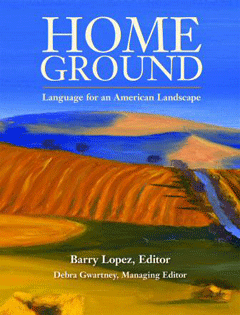The Language of Landscape
Air Date: Week of February 29, 2008

Home Ground: Language for an American Landscape, edited by Barry Lopez and Debra Gwartney. (Courtesy of Trinity University Press)
Living on Earth continues its series exploring features of the American landscape. It’s based on the book “Home Ground: Language for an American Landscape,” edited by Barry Lopez and Debra Gwartney. In this installment, Eva Saulitis explains the term “pack ice.”
Transcript
[MUSIC: Daniel Lanois “O Marie (Homeground Theme)” from ‘Acadie’ (Daniellanois.com – 2005)]
CURWOOD: Though rising temperatures are already thawing the frozen seas, some features of the icy oceans are indelibly part of our landscape and language, and evocatively described in the book “Home Ground.”
Barry Lopez and Debra Gwartney created this compilation of landscape terms, to create pictures in our minds of the features of our planet. Today, Eva Saulitis reads her definition of – pack ice.
SAULITIS: Pack ice. In winter, a quixotic carapace of drifting sea-ice blankets millions of square miles of the Polar Ocean. In Nupiak Eskimo, called the permanent part of the polar pack, consisting of both multiple year and annual pack ice – a conga siku, mother ice. The English-language term is meant to include as well the extensive fields of younger, mobile ice of the year, the seasonal or annual ice that may stretch much farther to the South as winter settles in. During storms, pack ice cries out, grinding, screeching. Winds, tides, and currents mangle flows into pressure ridges, or rip them apart to form temporary open water leads.

Home Ground: Language for an American Landscape, edited by Barry Lopez and Debra Gwartney. (Courtesy of Trinity University Press)
Eskimos in arctic Alaska hold quite a different view. For these native people, annual ice forming over the continental shelf equals life. In summer, melting pack ice releases fresh water and nutrients, helping spin a food web – algae, flagellets, zooplankton, fishes, mammals. Polar bears and many species of seal and whale are entirely dependent on pack ice for survival. When the pack drifts far to the North, Eskimo hunters scan the seaward horizon expectantly for its reflection in the sky. Ice blink: a brightness in the clouds.
In recent years, summer pack ice, reduced by global warming, remains farther offshore and less accessible to hunters. In this century, if current projections of continuous climate warming are correct, the shrinking ice pack will transform the Northwest passage from occasional adventure to commonplace reality.
[MUSIC: Various Artists “All Alone (On Eilean Shona)” from One Giant Leap (Palm Pictures 2001)]
CURWOOD: Eva Saulitis is a biologist and writer from Homer, Alaska. Her description of Pack Ice comes from the book “Home Ground, Language for an American Landscape,” compiled by Barry Lopez and Debra Gwartney.
Links
Living on Earth wants to hear from you!
Living on Earth
62 Calef Highway, Suite 212
Lee, NH 03861
Telephone: 617-287-4121
E-mail: comments@loe.org
Newsletter [Click here]
Donate to Living on Earth!
Living on Earth is an independent media program and relies entirely on contributions from listeners and institutions supporting public service. Please donate now to preserve an independent environmental voice.
NewsletterLiving on Earth offers a weekly delivery of the show's rundown to your mailbox. Sign up for our newsletter today!
 Sailors For The Sea: Be the change you want to sea.
Sailors For The Sea: Be the change you want to sea.
 The Grantham Foundation for the Protection of the Environment: Committed to protecting and improving the health of the global environment.
The Grantham Foundation for the Protection of the Environment: Committed to protecting and improving the health of the global environment.
 Contribute to Living on Earth and receive, as our gift to you, an archival print of one of Mark Seth Lender's extraordinary wildlife photographs. Follow the link to see Mark's current collection of photographs.
Contribute to Living on Earth and receive, as our gift to you, an archival print of one of Mark Seth Lender's extraordinary wildlife photographs. Follow the link to see Mark's current collection of photographs.
 Buy a signed copy of Mark Seth Lender's book Smeagull the Seagull & support Living on Earth
Buy a signed copy of Mark Seth Lender's book Smeagull the Seagull & support Living on Earth

